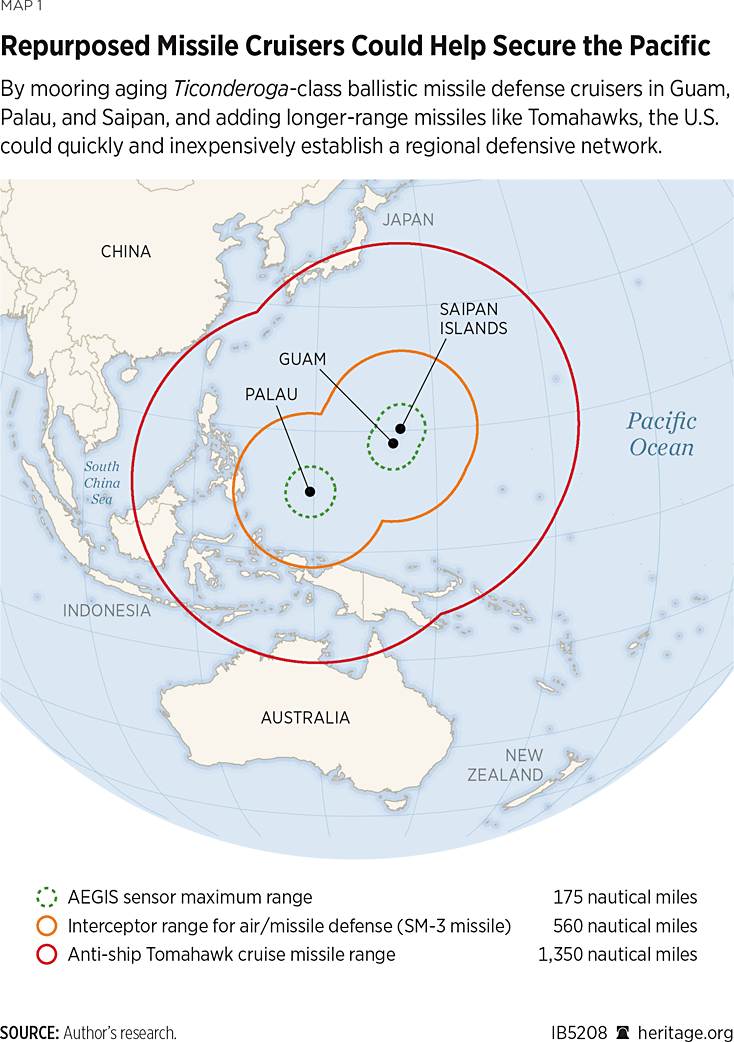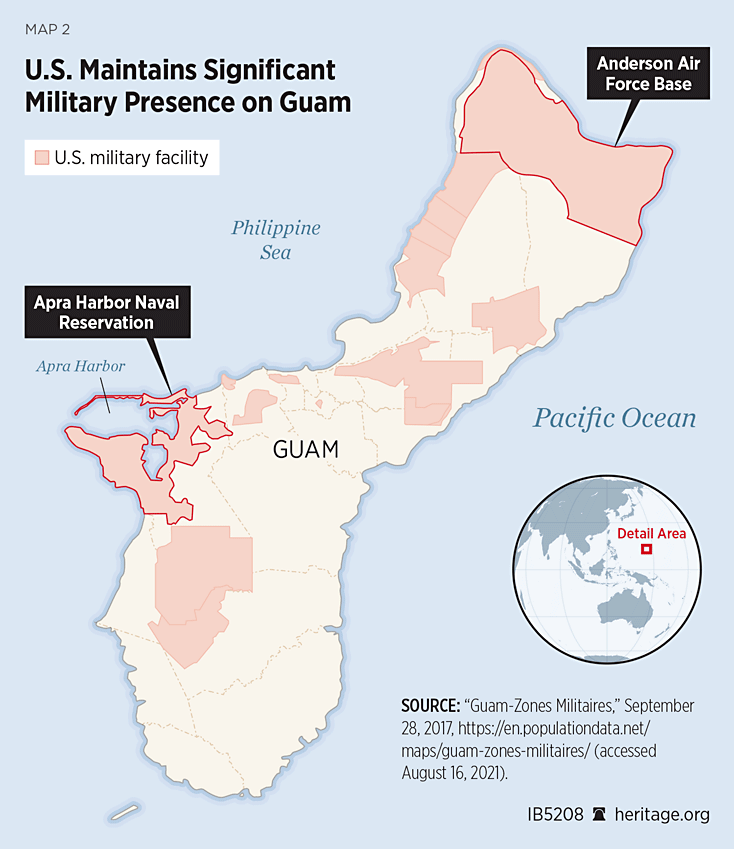Guam, home to 168,000 U.S. citizens, is where America’s day begins—so goes the unofficial motto. Guam is also a critically important strategic hub for U.S. military operations throughout the Indo–Pacific. It is unsurprising, then, that its defense from a massive and modern Chinese missile arsenal is at the top of the Indo–Pacific Command’s (INDOPACOM’s) wish list.
This is not a new request; the danger to Guam dates back to the Cold War when Soviet bombers would occasionally circumnavigate the island in a show of force, and Russian bombers still do, such as in 2007, 2013, and 2015. Today, however, Russian bombers are joined by a Chinese arsenal intended to deter the U.S. from intervening in defense of Allies in Asia—in particular to thwart any U.S. effort honoring commitments of the Taiwan Relations Act. For this reason, defense of U.S. citizens and the military infrastructure on Guam is a national imperative that the U.S. must not ignore.
Devising a perfect missile defense of Guam is impossible and certainly cost prohibitive—but that is not required. What is required is a defense that complicates Chinese wartime plans by keeping the Air and Naval Forces on Guam in the fight. To this end, INDOPACOM has proposed a Guam Defense System centered on current systems, notably a proven system called AEGIS Ashore—but, even if money were appropriated tomorrow, it would not be operational on Guam for at least three years. However, the threat is present today, and improved defense cannot wait: Near-term cost-effective defenses must be deployed until a more substantial one can be placed on Guam.
Even though Guam is a small island, its geography and dispersed critical infrastructure necessitates a distributed defense. A distributed defense also makes it harder for a concentrated and sustained Chinese or Russian attack to suppress military operations on the island. Some of the most critical assets on the island are the air base (Andersen Air Force Base) on the northern end of the island and its associated fuel depots, which sustain air operations throughout the western Pacific and the naval base at Apra Harbor, which is home to special forces, a submarine squadron, and critical Naval logistics. Because of their importance, these two clusters of military installations would be the most likely target of a Chinese missile attack.

Guam is not completely unprotected today. During a tense period in 2013 amidst North Korean threats to the island, the U.S. positioned a Terminal High Altitude Area Defense (THAAD) battery and its associated radar system on the island, where it remains today.REF This is useful against a limited ballistic missile threat from North Korea, but is inadequate for a saturation attack from China with ballistic and cruise missiles. So, the Navy deploys ballistic missile defense (BMD)–capable warships as needed, but tethering these ships to Guam comes at a cost to defending aircraft carriers from air, missile, and submarine threats at sea.
As the U.S. Navy has gotten smaller overall, using a multimission warship to defend Guam from a missile attack is unsustainable—those ships are needed elsewhere at sea. This is one reason why INDOPACOM has proposed a Guam Defense System centered on an AEGIS Ashore system, which could free up three warships from duty around Guam.
The proposal for Guam calls for a fixed and persistent 360-degree integrated air and missile defense system. Yet the Department of Defense has not demonstrated full support for this effort. The fiscal year (FY) 2022 defense budget omitted the $350 million requested by INDOPACOM for defense of Guam—with the Senate Armed Services Committee (SASC) proposing an additional $700 million to fulfill the top unfunded request by INDOPACOM’s Admiral John Aquilino.REF Nonetheless, the President’s budget did provide the Missile Defense Agency with $118.3 million for FY 2022 to further develop joint Army–Navy capabilities in defense of Guam. But, again, it would likely be years before meaningful defenses arrive on Guam.REF And even if the additional funding that the SASC proposes is appropriated, it will also be at least three long years before a system could be in Guam. Until that day arrives, what can be done?
Existing Options for Defending Guam
Thankfully there are options that could be deployed to Guam today, which would measurably complicate Chinese operational thinking in attacking and suppressing Guam. First, there are three aging BMD-capable Ticonderoga-class cruisers (the CG-73, the CG-72, and the CG-61) that the Navy has slated for decommissioning in 2022 due to high operational cost.REF Their older analog radar systems, while still capable, have a limited capacity for engaging multiple targets and require auxiliary systems to cool associated electronics. Second, the cruise missile threat could be addressed by repurposing elements of the Army’s Counter Rocket, Artillery, and Mortar (C-RAM) systems.
Ticonderoga-class cruisers were designed to provide air defense to carrier strike groups, with later upgrades that enabled ballistic missile defense. As retired Admiral and ex-Commander of INDOPACOM Harry Harris recently argued, any future defense system for Guam must be integrated across numerous systems—these cruisers do that already.REF Early in their lifetime, these cruisers got the upgrades and space needed to support an Area Air Defense Commander with associated communications, sensors, and weapons.REF With this in mind, these ships could serve as an operational test bed for integrating newer systems, such as the Army’s highly capable TPY-2 radar, into the targeting of the 120 missiles carried in the cruiser’s vertical launch system.
The Navy’s rationale for retiring the three BMD-capable cruisers was the high cost of continuing to operate them at sea due to overdue maintenance; especially their fuel tanks, which have been known to leak. With a crew of 312 officers and sailors, these still-capable warships have functional AEGIS sensors, communications suites, and over 120 vertical launch tubes for air and missile defense weapons—significant firepower not easily replaced.
Typically, when the Navy deploys a BMD warship to defend Guam, it loiters in waters near the island or moored in port. Guam offers several protected anchorages that a moored BMD-capable cruiser could move between without having to conduct prolonged navigation. This potentially obviates the need for the Navy to man or maintain these ships for independent at-sea operations—potentially escorted or towed between mooring sites. This would enable putting the ship’s propulsion system in a state of reduced operational readiness and reducing the crew, but to be clear, cost savings is a secondary consideration to sustaining weapons capacity for defense (and potentially strike).
Demand for such repurposed cruisers in a moored missile defense role exist elsewhere, and could further alleviate the missile defense mission of limited numbers of warships. Until July 2020, Japan had identified the need for two AEGIS ashore installations, but canceled them due to local concern of danger from falling booster rockets.REF A mobile moored capability could mitigate the missile danger in the near term, while providing a less costly option that reduces operational demands on U.S. Seventh Fleet ships in the area until Japan procures additional BMD-capable destroyers, which would not be delivered to Japan’s Self-Defense Forces for several years anyway.
Finally, there is further utility of these ships given recent offers by the government of Palau to host U.S. forces, and increased U.S. attention on the Commonwealth of the Northern Mariana Islands, specifically Saipan and Tinian, for a diversion airfield supporting forward operations.REF As in Guam, mooring these cruisers at Palau and Saipan can set the foundation for a regional defense network that can mature over time, as more capable systems come online.
C-RAM and THAAD. C-RAM is an Army system that was deployed to Iraq and Afghanistan to defend forward-operating bases from low-trajectory rocket and mortar attack. One element of this system is of special interest—the M61A1 20mm Gatling gun with integrated radar and fire control.REF The M61A1, in its naval form originally designed for point defense against cruise missile and air threats to Navy warships, is also known as R2-D2 because of its uncanny resemblance to the famed Star Wars “droid.” As part of an integrated air and missile defense system for Guam, this proven and deployable system could fill a niche against slower and lower-flying cruise missiles launched against the island.
While neither C-RAM nor repurposing of aged BMD-capable cruisers represents a long-term solution to the defense of Guam, together with THAAD, they do significantly improve it. In the near term, these cruisers could provide added firepower, sensor coverage, and a platform for integrated air and missile defense command and control until follow-on dedicated systems arrive. Doing this also frees up three front-line AEGIS-equipped destroyers for a range of other pressing missions.
A Phased Approach with Near-Term Solutions
The most notable long-term solution for Guam is a yet-to-be designed disaggregated AEGIS Ashore, which the Missile Defense Agency has admitted is still under review, meaning it will likely be several years before there is even an approved plan. This, at a time that INDOPACOM has warned Congress that China is making every preparation for a conflict over Taiwan by 2027.REF As Heritage Foundation analyst Patty-Jane Geller has argued, the best way forward is a phased approach involving near-term solutions until future capabilities, such as AEGIS Ashore and its updates, arrive in Guam.REF With this urgency in mind,
The Navy should:
- Repurpose the three BMD-capable Ticonderoga-class cruisers for moored-area integrated air and missile defense operations. To accomplish this:
- The Chief of Naval Operations must rescind the decision to decommission CG-61, 72 and 73, and devise appropriate manning plans to include the increased use of reservists; and
- The Secretary of the Navy should examine the utility of collaborating with Japan in further alleviating the BMD-mission burden on the fleet, while engaging the governments of Palau and Saipan on the feasibility of mooring these ships in their harbors.
The Secretary of Defense should:
- Direct the deployment of M61A1 components of the C-RAM to Guam for cruise missile defense. Doing this will require INDOPACOM to direct the U.S. Army Pacific Command, in consultation with the Navy, to recommend cruise missile defense as part of an integrated defense on Guam.
Congress should:
- Meet INDOPACOM’s unfunded requests for defense of Guam, and mandate a semi-annual Department of Defense progress report to better inform future budgets. These reports should include updates on near-term defense measures (such as the C-RAM and repurposed BMD cruisers) and maturity of more capable future defenses.
Set a requirement that future warship decommissioning plans be associated with delivery of matching firepower to sustain the overall fleet’s warfighting capacity. Should original plans to decommission seven Ticonderoga-class cruisers in FY 2022 happen, that would amount to a reduction of 9 percent in the overall surface fleet’s missile firepower.

Conclusion
No defense of Guam will be perfect, and damage to the military installations on the island should be expected, along with associated disruptions to military operations during conflict. However, a more adequate integrated air and missile defense of the island can mitigate such disruptions, and can make it harder for such attacks by China to succeed. Hardening U.S. defenses on Guam also bolsters the credibility of U.S. security commitments in the Indo–Pacific.
Brent D. Sadler is Senior Fellow for Naval Warfare and Advanced Technology in the Center for National Defense, of the Kathryn and Shelby Cullom Davis Institute for National Security and Foreign Policy, at The Heritage Foundation.



